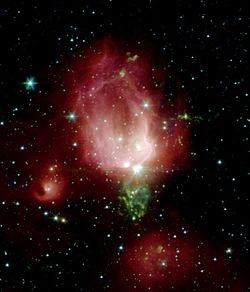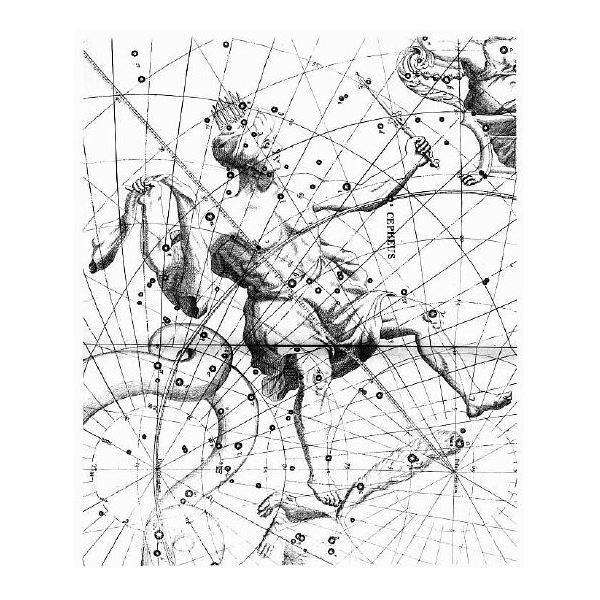
The mythological stories behind the constellations help us in distinguishing them among the group of constellations. Ptolemy has described the constellations in a systematic way so as to enable the astronomers to understand their position and concentrate on other critical and significant factors pertaining to them. The constellation Cepheus was well described by Ptolemy as a celestial king wearing a crown–like head–dress similar to those worn by the Persian rulers. Located in the northern hemisphere in the sky, Cepheus is also known as the King as it was named after the mythical king Cepheus of Ethiopia. A constellation of the Perseus family, it can be best seen in the month of November at 9 pm.
Cepheus has numerous stars, some of its major stars include:
- Alderamin or Alpha Cephei: It is the brightest star of this constellation. Its name is derived from an Arabic phrase meaning ‘the right arm’. It currently evolves from a main sequence star into a sub giant and never sets below the horizon. The star has a high speed, that is, at least 246 km/s and it completes one revolution within less than 12 hours. With an apparent magnitude of about 2.5141, it can be seen from the naked eye. It is approximately 49 light years distant.
- Alfirk or Beta Cephei: It is a triple star. The name Alfirk is derived from the Arabic word al–firqah meaning ‘the flock’. They are main sequence stars with solar masses between 7 and 20. Due to the pulsations of their surfaces, they show variations in brightness. As the star rotates at a speed of about 28 km/s, it takes 51 days to complete a single revolution and hence, the star is a slow rotator. Its apparent magnitude varies between 3.15 and 3.21 and it is approximately 690 light years distant from the earth.
- δ Cephei or Delta Cephei: It is a double star and serves as the prototype for the Cepheid class of stars. It is the only star that belongs to this class of stars. Its apparent visual magnitude varies between 3.48 and 4.37 and lies approximately 891 light years away from the solar system.
- Alrai or Gamma Cephei: A binary star, it is derived from the Arabic word meaning ‘the shepherd’. Classified as an orange sub giant, it is believed to be 6.6 billion years old and can be seen from the naked eye. With an apparent magnitude of about 3.22, it is about 45 light years distant.
- ζ Cephei or Zeta Cephei: It is an orange sub giant and is eight times more massive than the sun. It marks the left shoulder of Cepheus and has a surface temperature of 4,310 k. It has an apparent magnitude of 3.39 and is approximately 730 light years distant.
- η Cephei ro Eta Cephei: It is another orange giant star. Its traditional name is Al kidr in Arabic. The star is approximately 45 light years distant.
- Garnet Star or Mu Cephei: It is a red supergiant star. The distance of the star is uncertain as it is too far from its distance. It is one of the most luminous and largest stars ever observed in the entire galaxy. Mu Cephei is approaching its final stages of life and has begun to fuse helium into carbon. Its apparent magnitude is about 4.08 and is approximately 2,400 light years distant from the earth.
- VV Cephei or HD 208816: It is an eclipsing binary star as huge as the Garnet Star. It is approximately 2,400 light years distant and has an apparent magnitude of about 4.91.
- V381 Cephei: It is a red supergiant star.
- Kruger 60: It is a binary star composing of two red dwarfs that orbit each other in a period of 44.6 years.
It has several deep sky objects, some of the notable ones are:
- The Fireworks Galaxy (NGC 6946, Arp 29, Caldwell 12): It is an intermediate spiral galaxy that lies on the border between Cepheus and Cygnus. It was discovered by William Herschel in September 1798. Its apparent magnitude is about 9.6 and it is approximately 22 million light years distant.
- The Wizard Nebula or the NGC 7380: It is an open star cluster located with the Milky Way. Discovered by Caroline Herschel in 1787, the stars in it are less than five million years old, and hence, it is a young open cluster. It is approximately 7,000 light years distant from the solar system.
- NGC 7538: It is an emission or reflection nebula that contains the biggest proto–star ever discovered in astronomy. It is approximately 9,100 light years distant.
- NGC 188 or Caldwell 1: This is another open star cluster and also the oldest in its category. It lies about five degrees away from the North Celestial Pole and is approximately 5,400 light years distant.
- The Iris Nebula (NGC 7023, Caldwell 4): It is another reflection of nebula which is actually a star cluster inside a nebula. Its magnitude is about 6.8 and it is 1,300 light years distant.
- NGC 7129: This is an open star cluster, a star–forming region located in the reflection of a rosebud shaped nebula.
- NGC 7142: This is one more open cluster in Cepheus.

Seen between latitudes +90° and -10°, it lies in the northern hemisphere.
It occupies an area of 588 square degrees, making it the 27th largest constellation in the sky. Beta Cephei lies 595 light years away from the earth. Hence, it can be said that Cepheus constellation is at least 595 light years away from the earth.
According to a Greek mythology, Zeus placed Cepheus in the sky after his tragic death. Cepheus’ wife Cassiopeia was a very futile woman who once boasted of being more beautiful than the Nereids. It is also said that when Cepheus’ daughter was celebrating her wedding, his brother came in claiming that his daughter had been promised to marry him first. But when he refused, a fight took place and Perseus who was Cepheus son–in–law used the head of the monster Medusa; looking at it would turn anyone into a stone. Unfortunately, Cepheus and his wife did not look away from the head in time and were turned into stone.

The neighbouring constellations of Cepheus include Camelopardalis, Cassiopeia, Cygnus, Draco, Lacerta and Ursa Minor.
G Kowledge of | 0 Comments >>
0 Comments
Leave Comment
Your email address will not be published. Required fields are marked.